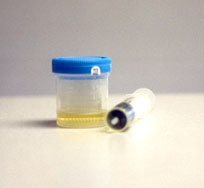- Nephritis - Inflammation of the kidney.
- Pyelonephritis - Inflammation of the kidney beginning at the "pelvis." The pelvis is the enlarged, hollow area inside the kidneys where urine pools before entering the ureter. Pyelonephritis is generally due to a bacterial infection.
- Glomerulonephritis - Inflammation of the kidney beginning at the level of the thousands of microscopic glomeruli. The glomeruli are the tiny structures in the kidney which filter water and waste products from the blood. Glomerulonephritis is thought to be due to destruction of the glomeruli by the bodyís own immune system.
- Medullary washout - Loss of the salt concentration gradient inside the kidney. The kidneyís ability to conserve water depends on a difference in saltiness inside the kidney. The outer part of the kidney (cortex) tends to be less salty than the inside (medulla). As diluted urine flows deeper into the center of the kidney, the increasing saltiness pulls water from the urine back into the body. This function allows the body to conserve water and concentrate urine. Medullary washout is, in essence, a loss of the ability to conserve the bodyís water stores by concentrating the urine. This can occur as a complication of various diseases of the kidney.
- Uroliths (stones) - Mineral deposits inside the kidneys or other parts of the urinary tract.
- Renal insufficiency/failure - State or condition where the kidneys are not functioning on an acceptable level. This is usually due to extreme inflammation and/or death of kidney tissue. Toxic compounds which should normally be filtered out of the bloodstream and into the urine begin to accumulate in the body. Death of enough kidney tissue will eventually lead to complete failure of the kidneys and death of the animal.
- Renal neoplasia - Cancer of the kidneys.
Clinical Signs: Clinical signs of kidney disease vary with the condition. Minor inflammation or irritation of the kidneys may not be detected at all.
- Pyelonephritis (bacterial infection of the kidney tissue) will usually result in a listless animal with a high fever and little interest in food. If pyelonephritis continues untreated and involves both kidneys, it can eventually result in kidney failure.
- Small kidney stones may be present for years without causing any obvious problems. Large stones lodged in the kidney may cause blood in the urine (hematuria), abdominal pain, and blockage of the affected kidney. Stones which dislodge from the kidney and pass into the small ureter tube may cause hematuria, abdominal pain, internal bleeding, and urine leakage into the abdomen (a life-threatening situation).
- Cancer of the kidney may cause abdominal pain, abdominal enlargement, vomiting, diarrhea, and hematuria. Cancer in the kidney may also cause pyelonephritis.
When 66-75% of kidney tissue becomes non-functional, the animal usually begins to exhibit classic signs of kidney failure: excessive thirst, increase in the frequency of urination (due to loss of ability to concentrate urine), vomiting (due to buildup of toxic waste products in the bloodstream which cause nausea), weight loss, lethargy, anorexia, and dehydration. Occasionally, certain animals will slow down in urine production rather than produce large quantities of dilute urine. Decreased urine production tends to be worse than increased production.
|
|
|
|
Diagnosis:
- Blood and urine testing are the key tests for the initial detection of kidney insufficiency/failure.
- Radiographs of the abdomen are useful in diagnosing many kidney stones (uroliths); however, not all stones will be visible on radiographs. Radiographs may also be helpful in diagnosing cancer of the kidney. Dye may be introduced into the bloodstream and radiographed as it passes through the kidneys. This allows a better view of kidney size, shape, and any possible blockages found therein. This technique is termed Intravenous Pyelography (IVP).
- Ultrasound is useful in discovering kidney stones (uroliths), including those which are not visible on X-rays. Abnormalities in kidney structure, shape, or composition can also be detected through the use of ultrasound. Ultrasound may also be used as a guide in obtaining a biopsy specimen from the kidney.
- Kidney biopsies and subsequent histopathology (microscopic evaluation of the tissue) are important in diagnosing certain types of kidney disease, such as glomerulonephritis or cancer (neoplasia).
In order to assess the patientís progress, repeated testing is vital while treating many types of kidney disease. For additional information on many of the above tests, see Section D.
Treatment: Treatment varies with the condition.
- Nephritis requires correcting the underlying problem. This may include antibiotic therapy for the patient with pyelonephritis, and immune system suppression for the patient with glomerulonephritis.
- Kidney stones (uroliths) often require removal via surgery. Some newer techniques are being explored which can break up stones into smaller fragments and allow them to pass without surgery.
- Kidney insufficiency or failure requires long term diet restrictions in protein and salt, fluid therapy or diuresis (causing the animal to urinate), appetite-stimulating drugs, and a variety of other medications. Kidney transplantation in animals is under study; it may be some time, however, before this option is made available to the general public.
- Cancer of the kidney requires surgical removal, a procedure which may challenge even the most experienced surgeons. Chemotherapy usually follows removal, but this depends on the type of cancer.
